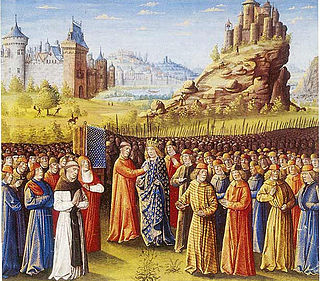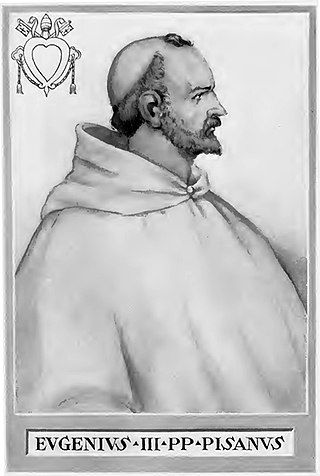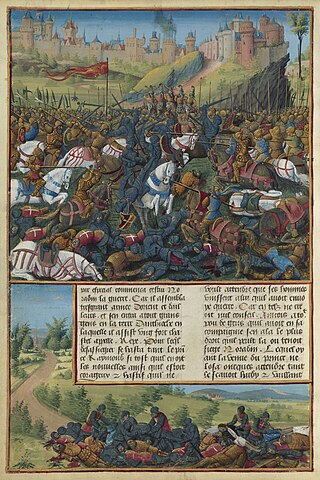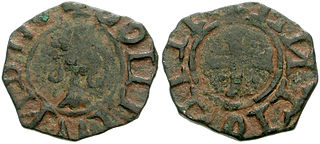Related Research Articles

Pope Eugene III, born Bernardo Pignatelli, or possibly Paganelli, called Bernardo da Pisa, was head of the Catholic Church and ruler of the Papal States from 15 February 1145 to his death in 1153. He was the first Cistercian to become pope. In response to the fall of Edessa to the Muslims in 1144, Eugene proclaimed the Second Crusade. The crusade failed to recapture Edessa, which was the first of many failures by the Christians in the crusades to recapture lands won in the First Crusade. He was beatified in 1872 by Pope Pius IX.
The 1140s was a decade of the Julian Calendar which began on January 1, 1140, and ended on December 31, 1149.

Year 1146 (MCXLVI) was a common year starting on Tuesday of the Julian calendar.

Year 1145 (MCXLV) was a common year starting on Monday of the Julian calendar.

The First Crusade (1096–1099) was the first of a series of religious wars, or Crusades, initiated, supported and at times directed by the Latin Church in the middle ages. The objective was the recovery of the Holy Land from Islamic rule. While Jerusalem had been under Muslim rule for hundreds of years, by the 11th century the Seljuk takeover of the region threatened local Christian populations, pilgrimages from the West, and the Byzantine Empire itself. The earliest initiative for the First Crusade began in 1095 when Byzantine emperor Alexios I Komnenos requested military support from the Council of Piacenza in the empire's conflict with the Seljuk-led Turks. This was followed later in the year by the Council of Clermont, during which Pope Urban II supported the Byzantine request for military assistance and also urged faithful Christians to undertake an armed pilgrimage to Jerusalem.

The Second Crusade (1147–1150) was the second major crusade launched from Europe. The Second Crusade was started in response to the fall of the County of Edessa in 1144 to the forces of Zengi. The county had been founded during the First Crusade (1096–1099) by King Baldwin I of Jerusalem in 1098. While it was the first Crusader state to be founded, it was also the first to fall.

The Eighth Crusade was the second Crusade launched by Louis IX of France, this one against the Hafsid dynasty in Tunisia in 1270. It is also known as the Crusade of Louis IX Against Tunis or the Second Crusade of Louis. The Crusade did not see any significant fighting as Louis died of dysentery shortly after arriving on the shores of Tunisia. The Treaty of Tunis was negotiated between the Crusaders and the Hafsids. No changes in territory occurred, though there were commercial and some political rights granted to the Christians. The Crusaders withdrew back to Europe soon after.

The Seventh Crusade (1248–1254) was the first of the two Crusades led by Louis IX of France. Also known as the Crusade of Louis IX to the Holy Land, it aimed to reclaim the Holy Land by attacking Egypt, the main seat of Muslim power in the Near East. The Crusade was conducted in response to setbacks in the Kingdom of Jerusalem, beginning with the loss of the Holy City in 1244, and was preached by Innocent IV in conjunction with a crusade against emperor Frederick II, Baltic rebellions and Mongol incursions. After initial success, the crusade ended in defeat, with most of the army – including the king – captured by the Muslims.

Bohemond IV of Antioch, also known as Bohemond the One-Eyed, was Count of Tripoli from 1187 to 1233, and Prince of Antioch from 1201 to 1216 and from 1219 to 1233. He was the younger son of Bohemond III of Antioch. The dying Raymond III of Tripoli offered his county to Bohemond's elder brother, Raymond, but their father sent Bohemond to Tripoli in late 1187. Saladin, the Ayyubid sultan of Egypt and Syria, conquered the county, save for the capital and two fortresses, in summer 1188.

The Wendish Crusade was a military campaign in 1147, one of the Northern Crusades, led primarily by the Kingdom of Germany within the Holy Roman Empire and directed against the Polabian Slavs. The Wends were made up of the Slavic tribes of Abrotrites, Rani, Liutizians, Wagarians, and Pomeranians who lived east of the River Elbe in present-day northeast Germany and Poland.

The siege of Damascus took place between 24 and 28 July 1148, during the Second Crusade. It ended in a crusader defeat and led to the disintegration of the crusade. The two main Christian forces that marched to the Holy Land in response to Pope Eugene III and Bernard of Clairvaux's call for the Second Crusade were led by Kings Louis VII of France and Conrad III of Germany. Both faced disastrous marches across Anatolia in the months that followed, with most of their armies being destroyed. The original focus of the crusade was Edessa (Urfa), but in Jerusalem, the preferred target of King Baldwin III and the Knights Templar was Damascus. At the Council of Acre, magnates from France, Germany, and the Kingdom of Jerusalem decided to divert the crusade to Damascus.

The siege of Edessa took place from 28 November to 24 December 1144, resulting in the fall of the capital of the County of Edessa to Zengi, the atabeg of Mosul and Aleppo. This event was the catalyst for the Second Crusade.
Hugh was the bishop of Jabala, or, as it was then called, Gibellum, a town in Syria, during the 12th century. When the County of Edessa fell to Zengi in 1144, Raymond of Antioch sent Hugh to report the news to Pope Eugene III. In response, Eugene issued the papal bull Quantum praedecessores the following year calling for the Second Crusade. Hugh also told the historian Otto of Freising about Prester John, the mythical Nestorian Christian priest-king of India, who was intending to help the Crusader States against the Saracens. Otto included the story in his Chronicon of 1145; it is the first recorded mention of the Prester John legend.
Alberic of Ostia (1080–1148) was a Benedictine monk, diplomat and Cardinal Bishop of Ostia from 1138 to 1148. He was one of the most important people in the administration of Pope Eugenius III, especially due to his diplomatic skills.

The Crusades were a series of religious wars initiated, supported, and sometimes directed by the Christian Latin Church in the medieval period. The best known of these military expeditions are those to the Holy Land in the period between 1095 and 1291 that were intended to reconquer Jerusalem and its surrounding area from Muslim rule. Beginning with the First Crusade, which resulted in the conquest of Jerusalem in 1099, dozens of military campaigns were organised, providing a focal point of European history for centuries. Crusading declined rapidly after the 15th century.
Theodwin was a German cardinal and papal legate of the 12th century.

The Council of Acre met at Palmarea, near Acre, a major city of the crusader Kingdom of Jerusalem, on 24 June 1148. The Haute Cour of Jerusalem met with recently arrived crusaders from Europe, to decide on the best target for the crusade. The Second Crusade had been called after the fall of Edessa to Zengi in 1144. In 1147, armies led by Conrad III of Germany and Louis VII of France began their separate journeys to the east. Conrad arrived at Acre in April 1148, and Louis marched south from Antioch.

Post miserabile is an encyclical issued by Pope Innocent III on 15 August 1198 calling for what would subsequently be referred to as the Fourth Crusade. It was Innocent's first crusade bull, although it was not issued in response to any single event, such as setback in the East. Compared to the crusade-related encyclicals written by his predecessors, Post miserabile is more organisational in tone, foreshadowing the bureaucratic and administrative changes Innocent would make to the crusading institutions.
The Crusade of 1129 or the Damascus Crusade was a military campaign of the Kingdom of Jerusalem with forces from the other crusader states and from western Europe against the Emirate of Damascus. The brainchild of King Baldwin II of Jerusalem, the crusade failed to meet its military objectives. Its diplomatic preliminaries, however, secured the succession to the throne of Jerusalem and papal backing for the Knights Templar.
References
- ↑ Paul Halsall (1996). Eugene III: Summons to A Crusade, Dec 1, 1154. Internet Medieval Sourcebook.
- 1 2 3 Runciman 1952, p. 248.
- 1 2 3 Setton 1958, p. 466.